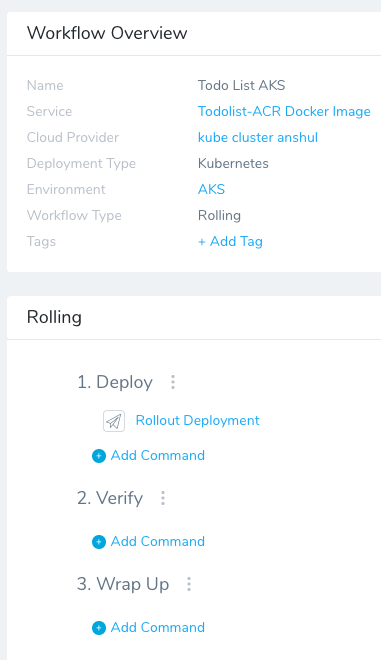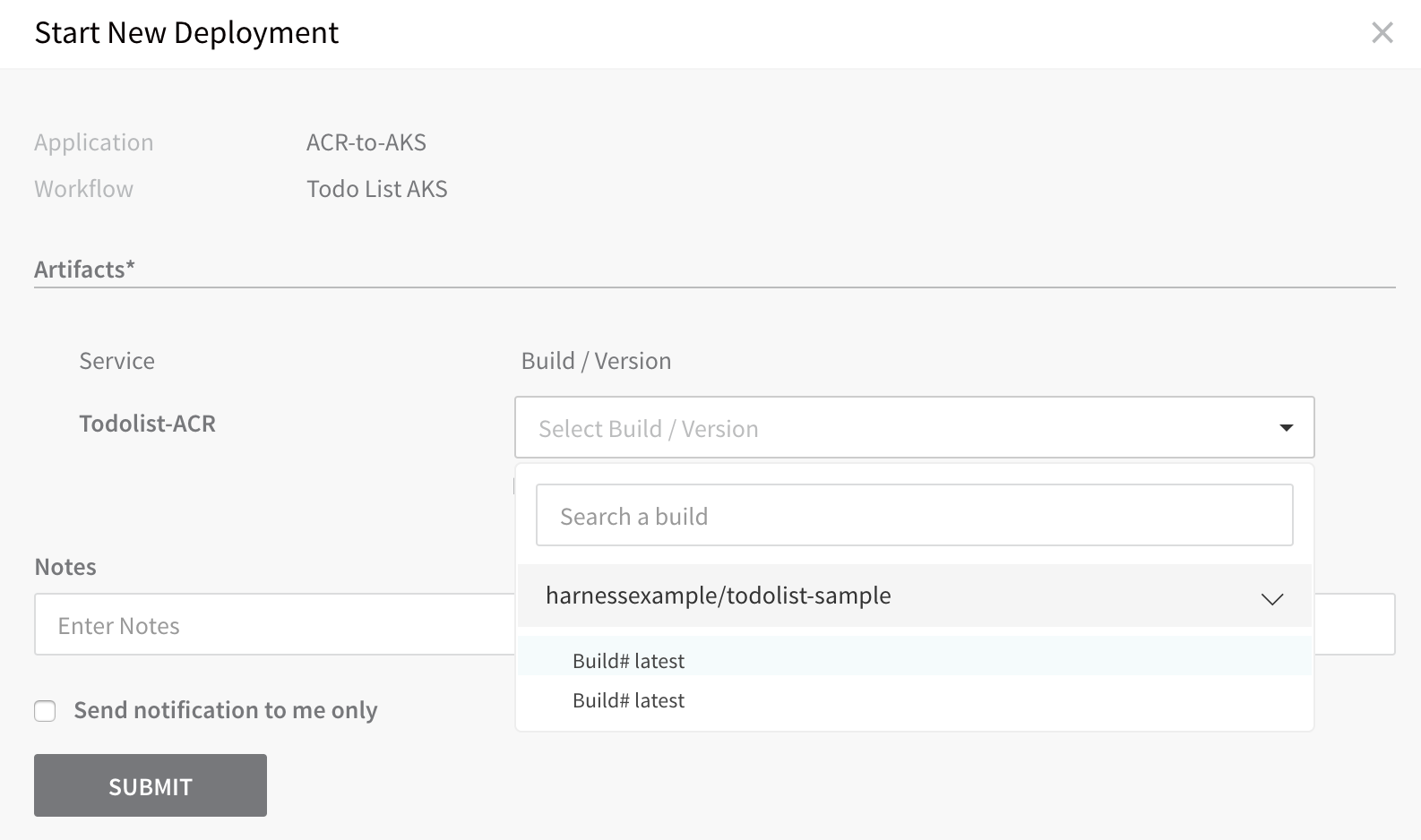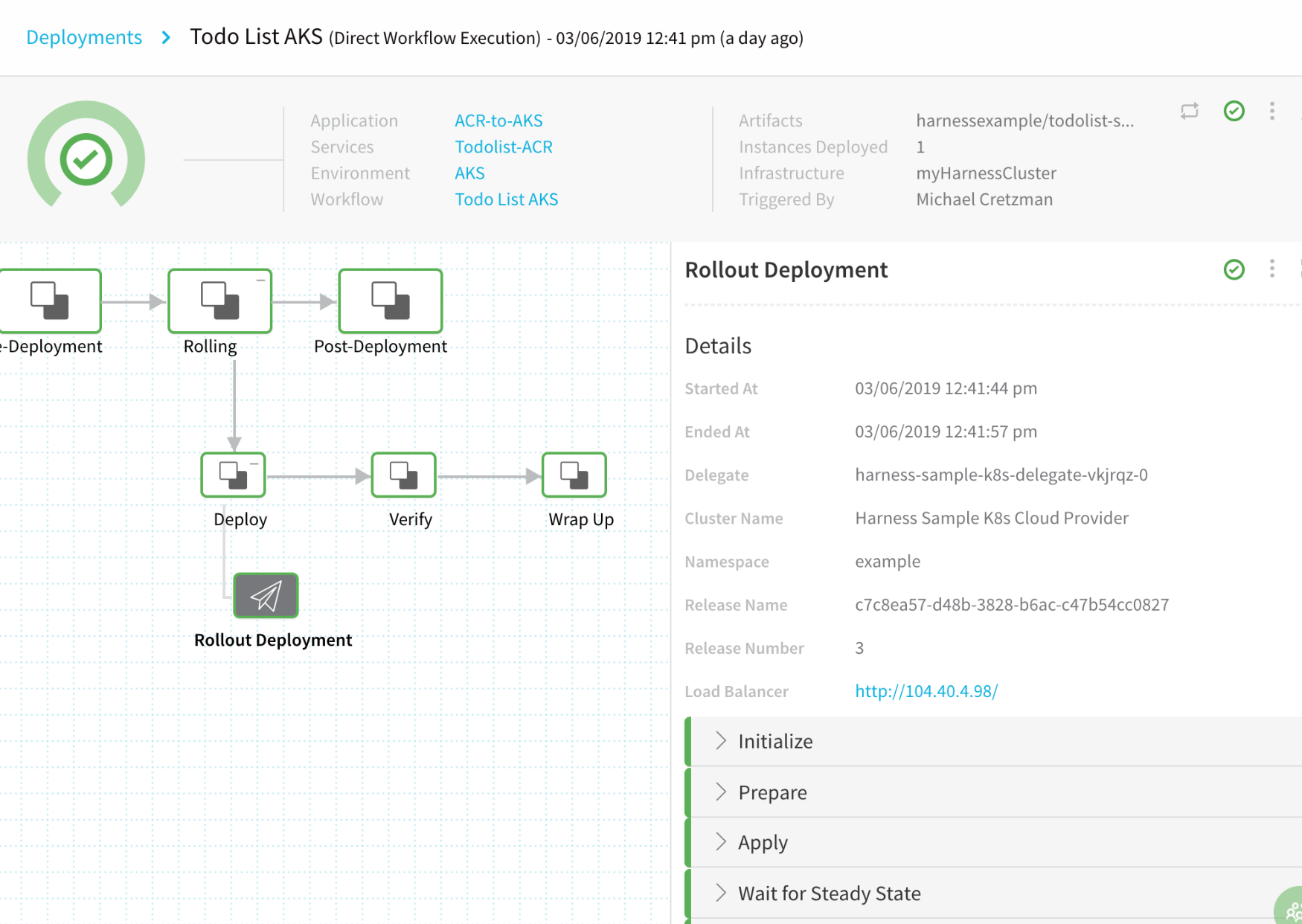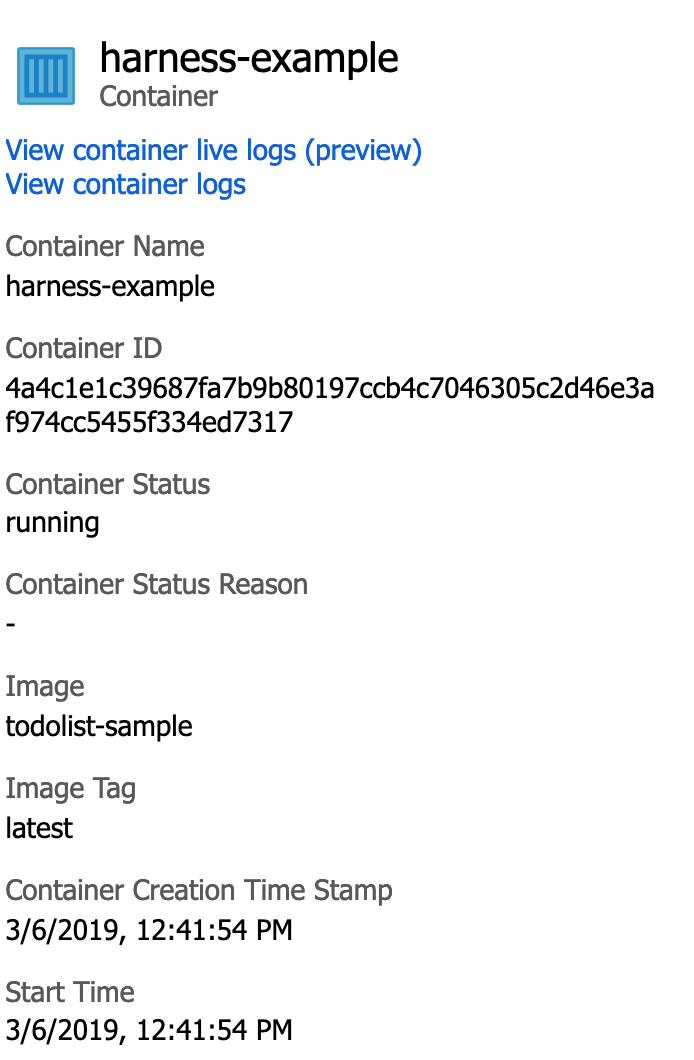4 - Azure ACR to AKS Workflows and Deployments
This content is for Harness FirstGen. Switch to NextGen.This section will walk you through creating a Kubernetes Workflow in Harness and what the Workflow steps deployment logs include:
Workflow Setup
In this guide, the Workflow performs a simple Rolling Deployment, which is a Kubernetes Rolling Update. For a detailed explanation, see Performing a Rolling Update from Kubernetes.
For information on other Workflow types, see Kubernetes Deployments.To create a Rolling Workflow for Kubernetes, do the following:
- In your Application, click Workflows.
- Click Add Workflow. The Workflow dialog appears.
- In Name, enter a name for your Workflow, such as Todo List AKS.
- In Workflow Type, select Rolling Deployment.
- In Environment, select the Environment you create for your Kubernetes deployment.
- In Infrastructure Definition, select the Infrastructure Definition you created earlier. If the Infrastructure Definition does not appear, ensure that you added the Service to the Infrastructure Definition Scope to specific Services setting.

- Click SUBMIT. The new Rolling Workflow is pre-configured.

As you can see, there is a Rollout Deployment step set up automatically. That's all the Workflow setup required. The Workflow is ready to deploy. When it is deployed, it will look like this:

You can see each section of the Rollout Deployment listed on the right. To see what that Rollout Deployment step does at runtime, let's look at the logs for each section.
Initialize
The Initialize step renders the Kubernetes object manifests in the correct order and validates them.
Initializing..
Manifests [Post template rendering] :
---
apiVersion: v1
kind: Namespace
metadata:
name: example
---
apiVersion: "v1"
kind: "Secret"
metadata:
annotations:
harness.io/skip-versioning: "true"
finalizers: []
labels: {}
name: "harness-example-dockercfg"
ownerReferences: []
data:
.dockercfg: "***"
stringData: {}
type: "kubernetes.io/dockercfg"
---
apiVersion: v1
kind: ConfigMap
metadata:
name: harness-example-config
data:
key: value
---
apiVersion: v1
kind: Service
metadata:
name: harness-example-svc
spec:
type: LoadBalancer
ports:
- port: 80
targetPort: 80
protocol: TCP
selector:
app: harness-example
---
apiVersion: apps/v1
kind: Deployment
metadata:
name: harness-example-deployment
spec:
replicas: 1
selector:
matchLabels:
app: harness-example
template:
metadata:
labels:
app: harness-example
spec:
imagePullSecrets:
- name: harness-example-dockercfg
containers:
- name: harness-example
image: harnessexample.azurecr.io/todolist-sample:latest
envFrom:
- configMapRef:
name: harness-example-config
Validating manifests with Dry Run
kubectl --kubeconfig=config apply --filename=manifests-dry-run.yaml --dry-run
namespace/example configured (dry run)
secret/harness-example-dockercfg created (dry run)
configmap/harness-example-config created (dry run)
service/harness-example-svc configured (dry run)
deployment.apps/harness-example-deployment configured (dry run)
Done.
Note the imagePullSecrets settings. Harness used the Go templating in Service to fully form the correct YAML for Kubernetes.
Prepare
The Prepare section identifies the resources used and versions any for release history. Every Harness deployment creates a new release with an incrementally increasing number. Release history is stored in the Kubernetes cluster in a ConfigMap. This ConfigMap is essential for release tracking, versioning and rollback.
For more information, see Releases and Versioning.
Manifests processed. Found following resources:
Kind Name Versioned
Namespace example false
Secret harness-example-dockercfg false
ConfigMap harness-example-config true
Service harness-example-svc false
Deployment harness-example-deployment false
Current release number is: 3
No previous successful release found.
Cleaning up older and failed releases
kubectl --kubeconfig=config delete ConfigMap/harness-example-config-2
configmap "harness-example-config-2" deleted
Managed Workload is: Deployment/harness-example-deployment
Versioning resources.
Done
Apply
The Apply section deploys the manifests from the Service Manifests section as one file.
kubectl --kubeconfig=config apply --filename=manifests.yaml --record
namespace/example unchanged
secret/harness-example-dockercfg created
configmap/harness-example-config-3 created
service/harness-example-svc unchanged
deployment.apps/harness-example-deployment configured
Done
Wait for Steady State
The Wait for Steady State section shows the containers and pods rolled out.
kubectl --kubeconfig=config get events --output=custom-columns=KIND:involvedObject.kind,NAME:.involvedObject.name,MESSAGE:.message,REASON:.reason --watch-only
kubectl --kubeconfig=config rollout status Deployment/harness-example-deployment --watch=true
Status : Waiting for deployment "harness-example-deployment" rollout to finish: 1 old replicas are pending termination...
Event : Pod harness-example-deployment-cfdb66bf4-qw5g9 pulling image "harnessexample.azurecr.io/todolist-sample:latest" Pulling
Event : Pod harness-example-deployment-cfdb66bf4-qw5g9 Successfully pulled image "harnessexample.azurecr.io/todolist-sample:latest" Pulled
Event : Pod harness-example-deployment-cfdb66bf4-qw5g9 Created container Created
Event : Pod harness-example-deployment-cfdb66bf4-qw5g9 Started container Started
Event : Deployment harness-example-deployment Scaled down replica set harness-example-deployment-6b8794c59 to 0 ScalingReplicaSet
Status : Waiting for deployment "harness-example-deployment" rollout to finish: 1 old replicas are pending termination...
Event : ReplicaSet harness-example-deployment-6b8794c59 Deleted pod: harness-example-deployment-6b8794c59-2z99v SuccessfulDelete
Status : Waiting for deployment "harness-example-deployment" rollout to finish: 1 old replicas are pending termination...
Status : deployment "harness-example-deployment" successfully rolled out
Done.
Wrap Up
The Wrap Up section shows the Rolling Update strategy used. Here is a sample:
...
Name: harness-example-deployment
Namespace: example
CreationTimestamp: Wed, 06 Mar 2019 20:16:30 +0000
Labels: <none>
Annotations: deployment.kubernetes.io/revision: 3
kubectl.kubernetes.io/last-applied-configuration:
{"apiVersion":"apps/v1","kind":"Deployment","metadata":{"annotations":{"kubernetes.io/change-cause":"kubectl apply --kubeconfig=config --f...
kubernetes.io/change-cause: kubectl apply --kubeconfig=config --filename=manifests.yaml --record=true
Selector: app=harness-example
Replicas: 1 desired | 1 updated | 1 total | 1 available | 0 unavailable
StrategyType: RollingUpdate
MinReadySeconds: 0
RollingUpdateStrategy: 25% max unavailable, 25% max surge
...
Events:
Type Reason Age From Message
---- ------ ---- ---- -------
Normal ScalingReplicaSet 25m deployment-controller Scaled up replica set harness-example-deployment-86c6d74db8 to 1
Normal ScalingReplicaSet 14m deployment-controller Scaled up replica set harness-example-deployment-6b8794c59 to 1
Normal ScalingReplicaSet 4s deployment-controller Scaled down replica set harness-example-deployment-86c6d74db8 to 0
Normal ScalingReplicaSet 4s deployment-controller Scaled up replica set harness-example-deployment-cfdb66bf4 to 1
Normal ScalingReplicaSet 1s deployment-controller Scaled down replica set harness-example-deployment-6b8794c59 to 0
Done.
AKS Workflow Deployment
Now that the setup is complete, you can click Deploy in the Workflow to deploy the artifact to your cluster.
Next, select the artifact build version and click SUBMIT.

The Workflow is deployed.

To see the completed deployment, log into your Azure AKS cluster, click Insights, and then click Controllers.

If you are using a older AKS cluster, you might have to enable Insights.The container details show the Docker image deployed:

You can also launch the Kubernetes dashboard to see the results:

To view the Kubernetes dashboard, in your AKS cluster, click Overview, click Kubernetes Dashboard, and then follow the CLI steps.